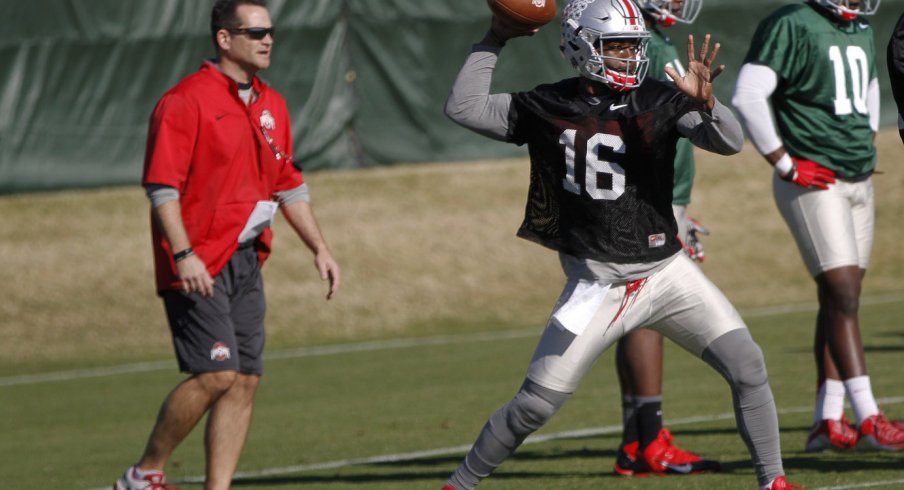While the 2015 Ohio State offense may have been one of the most talented units in school history, it certainly fell short of expectations.
The departure of play-caller Tom Herman certainly had an impact on the unit's production, as did the quarterback derby that dominated headlines throughout the first half of the season. Whatever the cause, the effect was felt most dramatically when the Buckeyes failed to get past Michigan State in November's home finale.
To many, J.T. Barrett should have been the starter from day one last fall, given his stature as the reigning player of the year in the Big Ten. But even once he took the reigns of the offense midway through last season, it took (too much) time before he and the unit finally played to their potential.
Yet even once OSU found its stride on that side of the ball, the game plan was fairly simple, relying heavily on the dominant inside running game of Ezekiel Elliott behind a veteran line. When Barrett did air it out, it was almost exclusively in one of two ways: quick 'three-step' routes to Michael Thomas or deep vertical throws off play-action.
The former was accomplished thanks to the talent of Thomas, while the latter only works if the running game is already going. With Thomas and Elliott now in the NFL, those strategies may be more difficult to replicate in the future.
Noticeably absent from the Buckeye offense was any kind of intermediate passing game. While Urban Meyer has rarely relied heavily on typical 'pro-style' aerial tactics during his coaching career, he may have to this fall with Barrett acting as one of the few known commodities on the current roster.
But even if all that talent were returning, there would still be the question about how effective that strategy may have been anyway. The year prior, the Buckeyes called far more two and three-route combinations instead of simply trying to isolate a single receiver against lesser competition, and the results were clear. Barrett's QB rating of 169.92 was the second-highest mark in the nation in 2014 but dropped a full 30 points with roughly half the attempts the following year.
As Barrett tries to regain his dominant form, there are some concepts that may help him not only jumpstart the Ohio State offense, but also make him more attractive to NFL scouts. These aren't new concepts either, as they're all somewhere in the Buckeye playbook already, but may be seen more as the Junior QB is asked to take on more responsibility.
1) Fade/Out
Not all play-action passes have to be deep balls. For years, Ohio State fans have clamored to see the tight end involved more frequently in the passing game, but with the game plan more focused on attacking downfield, there has been little room for the tight end to get involved.
With Marcus Baugh's place in the 2016 starting lineup written in ink, Meyer will have one of his most experienced players at tight end, thanks to the double-TE sets that were seen so frequently in 2015. One way to feature him is in the play-action game, once again building on a running game with high expectations.
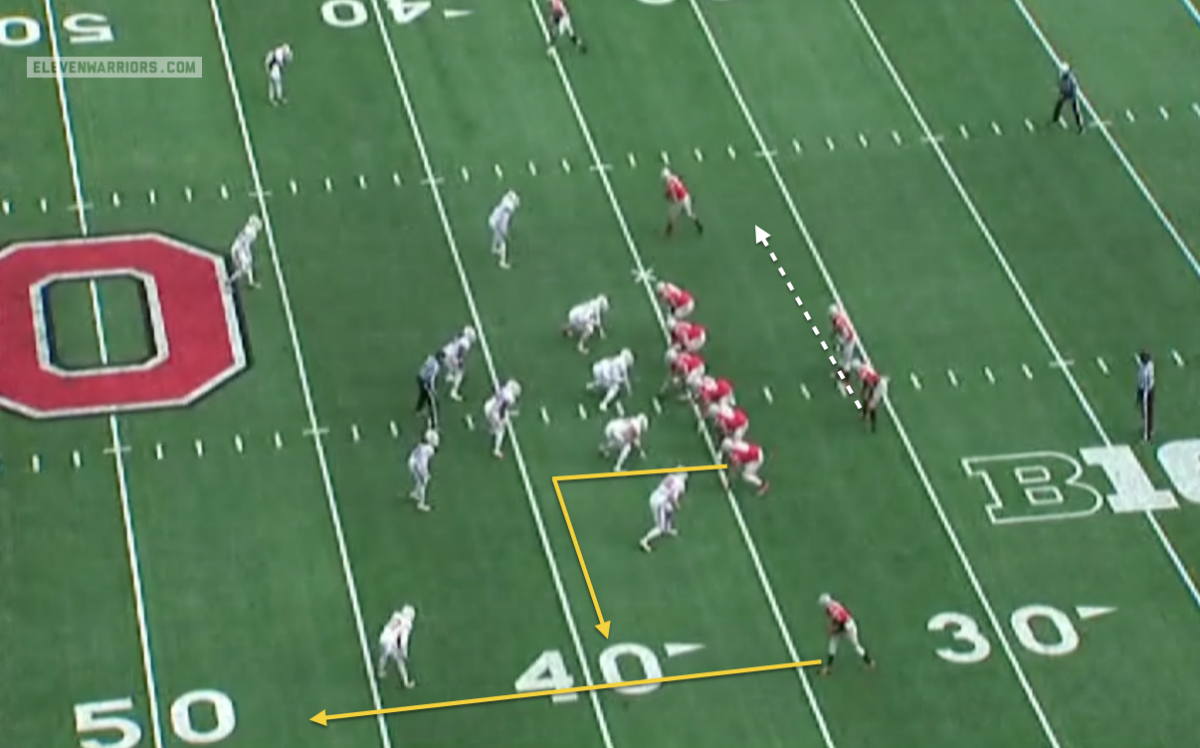
The route combination itself is a simple one, as the outside receiver simply clears out the flat area to the outside with a vertical pattern straight downfield, followed by the tight end running a quick 'out' to the vacated area. The backfield action is heading in the opposite direction, with the running back appearing to take a handoff that will lead him to the outside, such as he would in the 'Power-Read' concept.
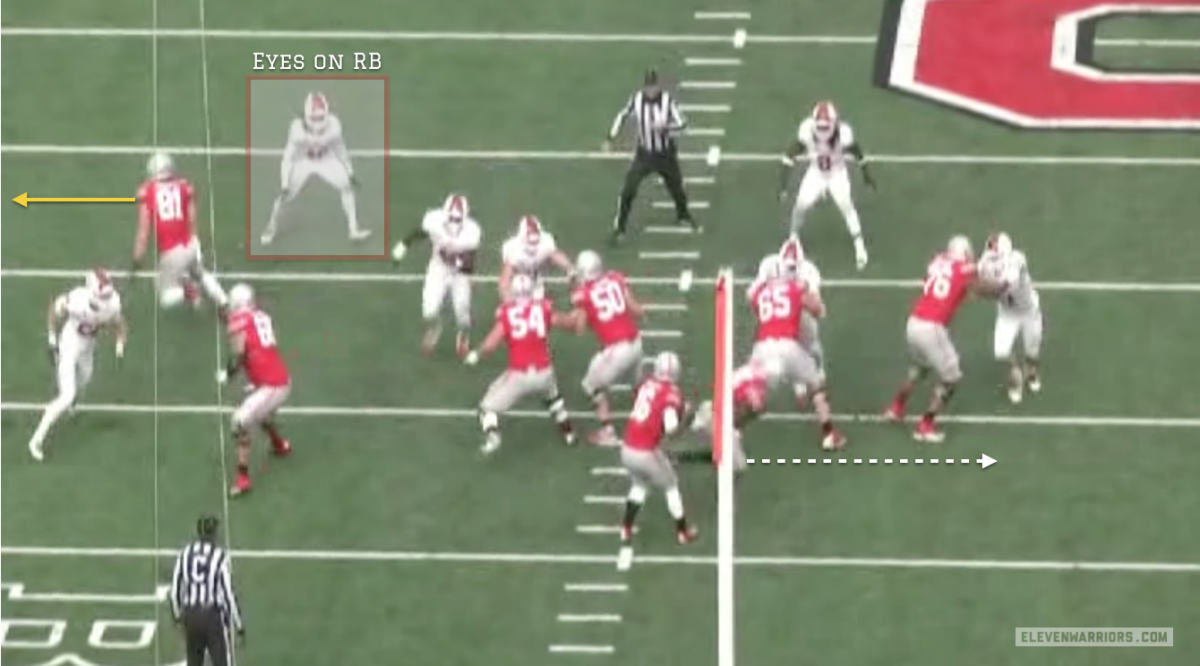
With defenses playing 'Cover 3' against the Buckeyes so often, looking to get eight defenders in the box to help against the run, the curl/flat defender is expected to have his eyes on that backfield action instead of focusing on the tight end. Not only is this defender slow to recognize a potential receiver releasing to the flat, the cornerback to that side is busy covering the fade route downfield.
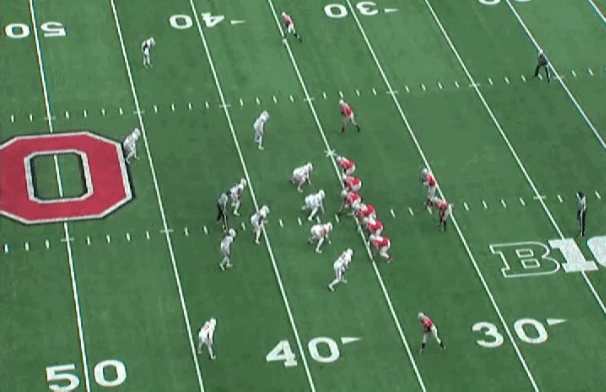
The result is a wide open tight end and a quick, easy throw for Barrett. For whatever reason, the Buckeyes haven't created these kinds of situations for the quarterback to get in an easy rhythm in the past, but hopefully, that will change.
2) Levels
One of the most misunderstood aspects of quarterback play is the idea that the best players are executing the most complex concepts. In reality, Peyton Manning and Tom Brady have been running many of the same simple pass plays that are found in every playbook for years, but with a higher rate of success. Their ability to identify where and when to call these concepts based on how defenses line up has been key, leading to personnel mismatches and easy completions.
One such concept is 'Levels,' which is one of Manning's favorite (and most successful) plays. The read is a very simple one, as a pair of crossing routes invades the 'seam' zone often occupied by outside linebackers or safeties.
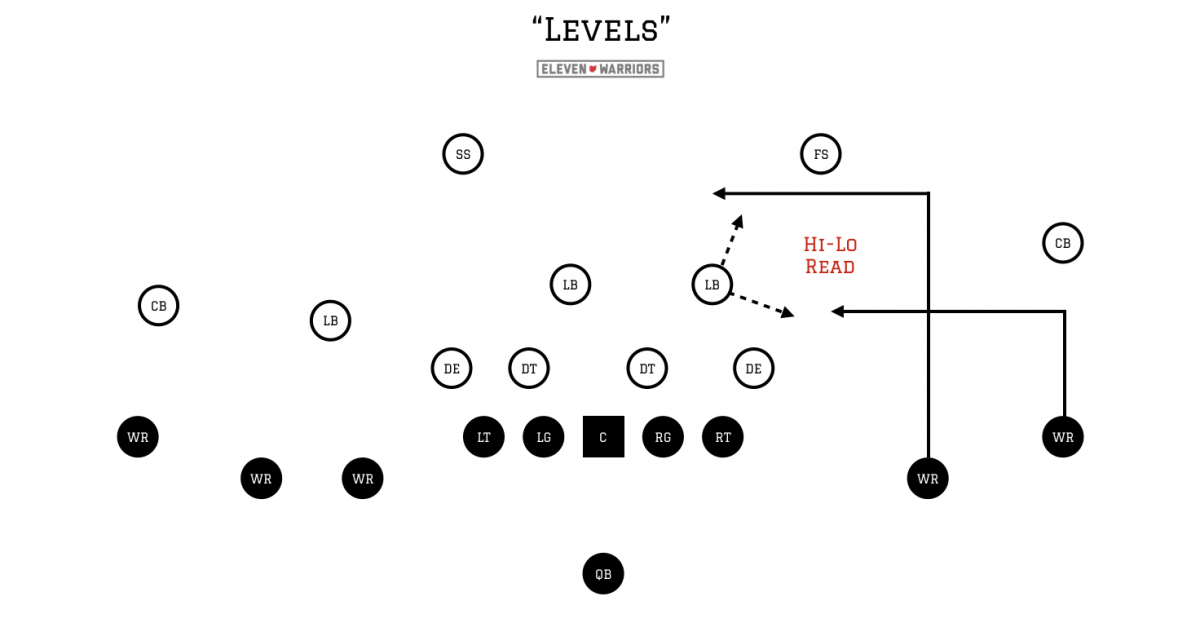
Instead of reading the receivers, the quarterback identifies this defender before the snap, often looking for the second intermediate defender inside. Much the same way they read an unblocked defender when running an option play, they simply make the throw based on whichever receiver is left uncovered.
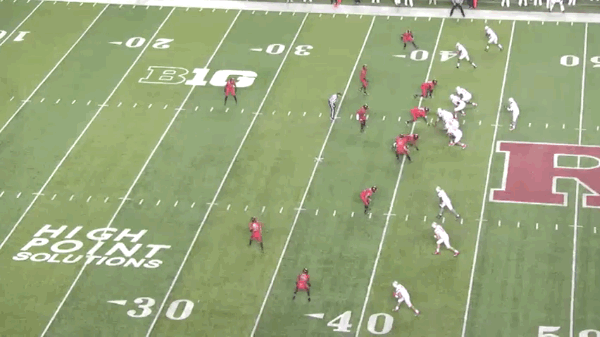
In this example, the outside linebacker drops back to gain depth with the slot receiver, leaving the underneath throw to the outside receiver wide open.
The beauty of this concept, however, is its versatility. While Ohio State often sees zone coverage on nearly every play, thanks to Barrett's running ability and defenses' desire to keep as many eyes in the backfield as possible, teams like Michigan have been playing more man-to-man coverage recently. 'Levels' can beat both zone or man defenses, as both receivers are always moving and able to create space between them and their defenders.
3) Mesh
With the trio of last year's starting receivers now in the NFL, there's no doubt that there will be some growing pains at the position in terms of technique. What they won't lack, however, is athleticism.
With a pair of converted running backs playing the 'H' slot receiver spot in Dontre Wilson and Curtis Samuel, the Buckeyes will likely look for ways to simply get them the ball with the chance to make a play in space. Screens and sweeps have been the most common ways of getting players like that involved in the past, but the 'Mesh' concept offers a way to include them in the dropback passing game.
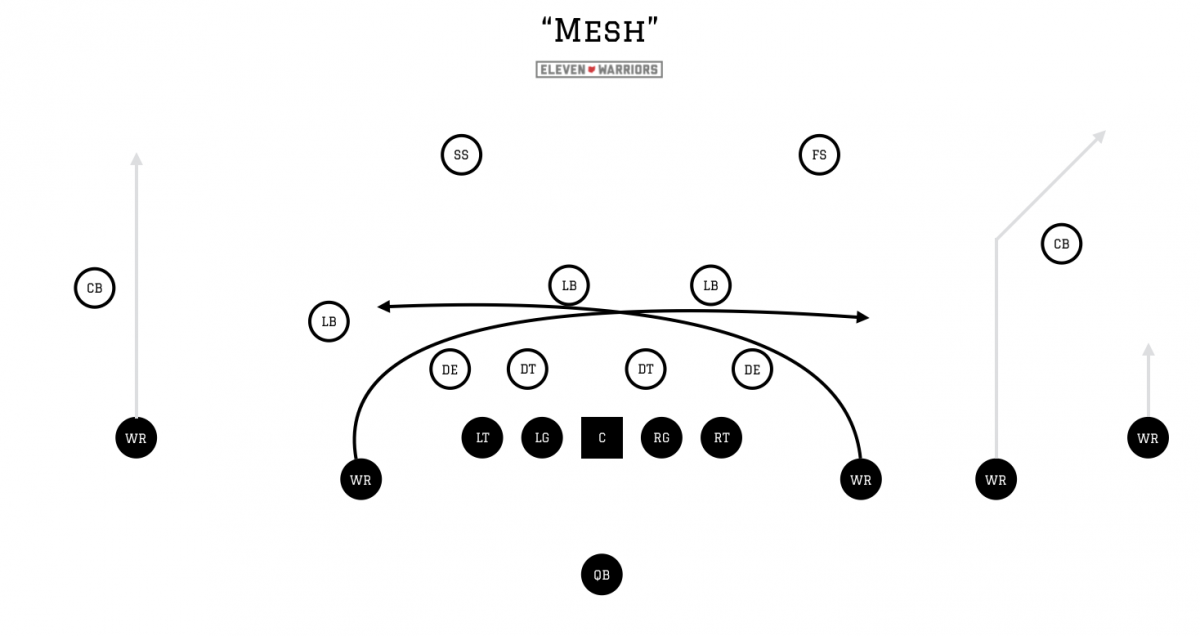
Unlike the other members of this list, 'Mesh' was actually seen in Ohio State's most recent contest, the Fiesta Bowl victory over Notre Dame. After struggling to get Braxton Miller the ball in creative ways throughout the season while he manned the 'H' spot, 'Mesh' allowed him to exploit the favorable matchups in coverage.
The Irish played a great deal of 'Quarters' coverage that day, hoping to replicate the success found by Michigan State against the Buckeyes with the same scheme. But with all four members of the secondary dropping deep, Miller's crossing route became the responsibility of the outside linebacker, who struggled mightily to keep up with the former QB's blazing speed.

The dual crossing routes have the potential to create a 'pick' as the defender chasing the intended receiver hopefully ends up in the path of the secondary player (played by tight end Nick Vannett in this example). With all the action directly in front of him, the throw for Barrett is an easy one, as he simply reads the inside linebackers to see how they defend the crossing routes and make a short throw to his receiver.
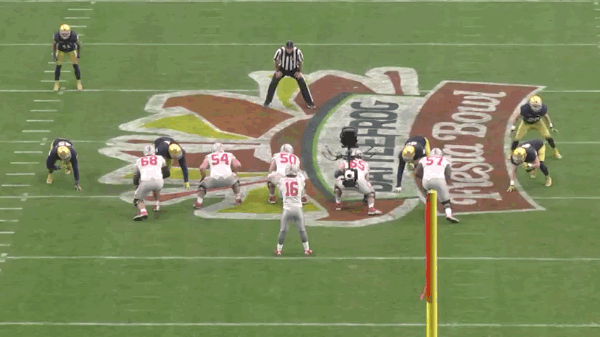
While Miller doesn't explode for a big gain, he's still able to shake the initial tackle from the trailing defender and squeak out a few extra yards. It's not hard to picture the duo vying to replace Miller doing the same to defenders this fall.
4) Seattle
Much in the way that not every play-action pass has to be a deep ball, not every deep ball in the Buckeye arsenal has to come off play-action. Since Meyer's arrival, his offenses have regularly featured the popular 'Four Verticals' concept, almost always combining it with a fake handoff in an attempt to stretch the field after first pulling the defense forward.
But if the run game isn't as effective, the offense must find a way to attack vertically on its own. One of Meyer's favorite means of accomplishing this task is via the 'Sail' concept, which sends three receivers to one side of the field and creating a vertical stretch for the zone defenders to that side. The play tore apart countless opponents in 2013 and ignited the OSU offense in the 2015 CFP Championship Game against Oregon.
Another similar concept that overloads one side of the field is the 'Seattle' concept, which some coaches simply call '999,' given that it features three '9' (fly/fade/vertical) patterns.
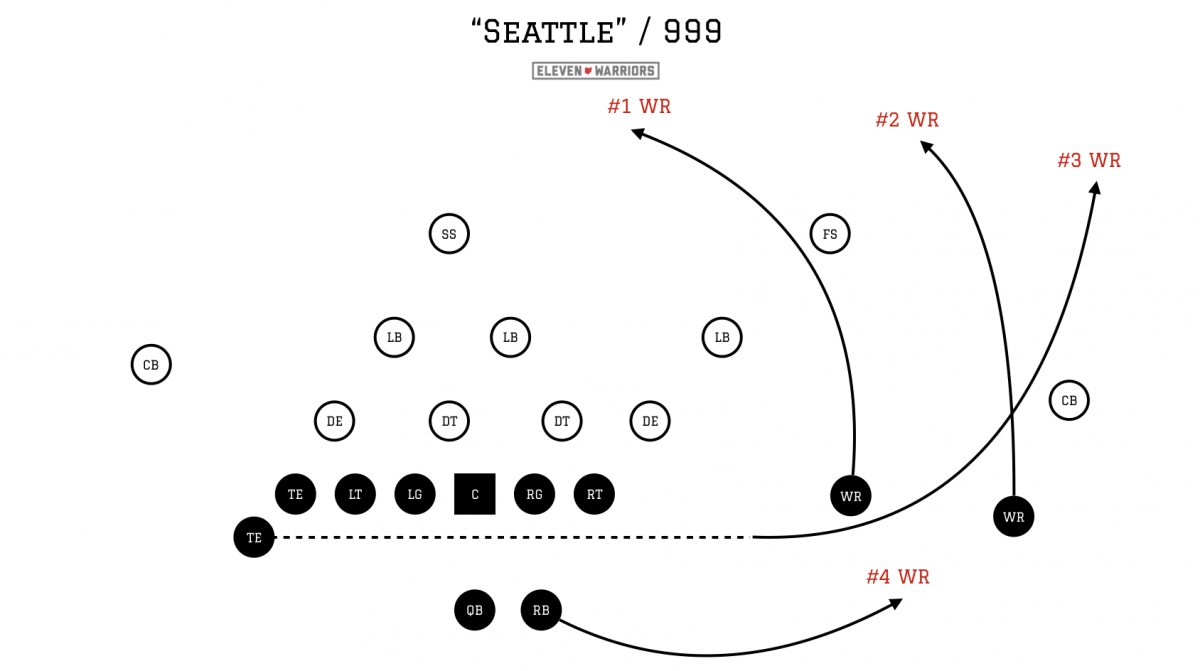
One of the beauties of the concept is the ability to execute it from formations that might not otherwise appear to deliver downfield threats. With two tight ends on one side and the back on the other, it certainly appears as if the offense is preparing to run around the left tackle.
But just before the snap, the tight end off the line comes in motion across the formation and feigns a blocking attempt before turning upfield. By the time he does does so, he's filling the void left behind by the two receivers who have attacked downfield, pulling the cornerback and safety with them.
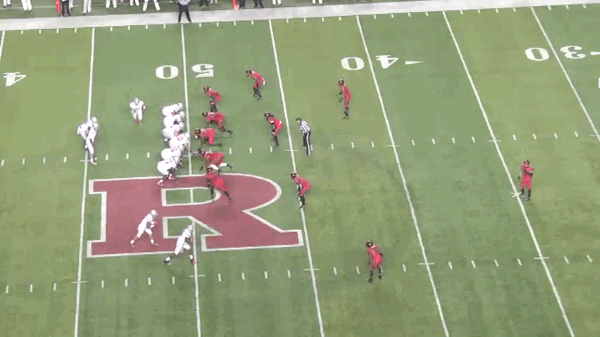
In this example against Rutgers last fall, the secondary does a good job of getting all the deep defenders in their 'Cover 3' scheme back far enough to take away the two deep routes, and the outside linebacker stays with the releasing tight end. But that left the middle linebacker in a foot race to get outside with the running back on a 'flare' route, a race the back will almost always win. Barrett is able to read deep-to-short and make an easy throw that results in a 10-yard pickup and keeps the chains moving.
But for these or any other concepts to find success on a consistent basis, Barrett will have to improve his decision-making after the snap. Although he's always been excellent at reading defenders in the option game, that skill has yet to consistently translate when passing. Far too often it appears that he locks on to receivers before the play starts and fails to recognize which of his receivers are actually open.
Even in his stellar 2014 campaign, there were hiccups in this department. Many critics simply blamed it on the fact that he was a freshman at the time, but as he enters his fourth year on campus, it's time for mistakes like these to be eliminated.
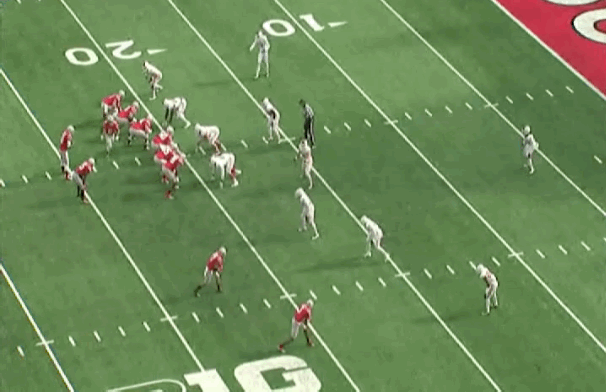
Most fans recall this contest against Indiana late in the 2014 season as one of Barrett's finest, in which he completed 25 of 35 attempts resulting in over 300 yards and four touchdowns through the air. But he absolutely should have added to those totals on this play which many simply blamed on misfortune. Although Evan Spencer, playing the role of the motioned receiver on this occasion, does get his hands on the ball before it caroms into the hands of the Hoosier defender, Spencer was double-covered while two receivers are open at the goal line.
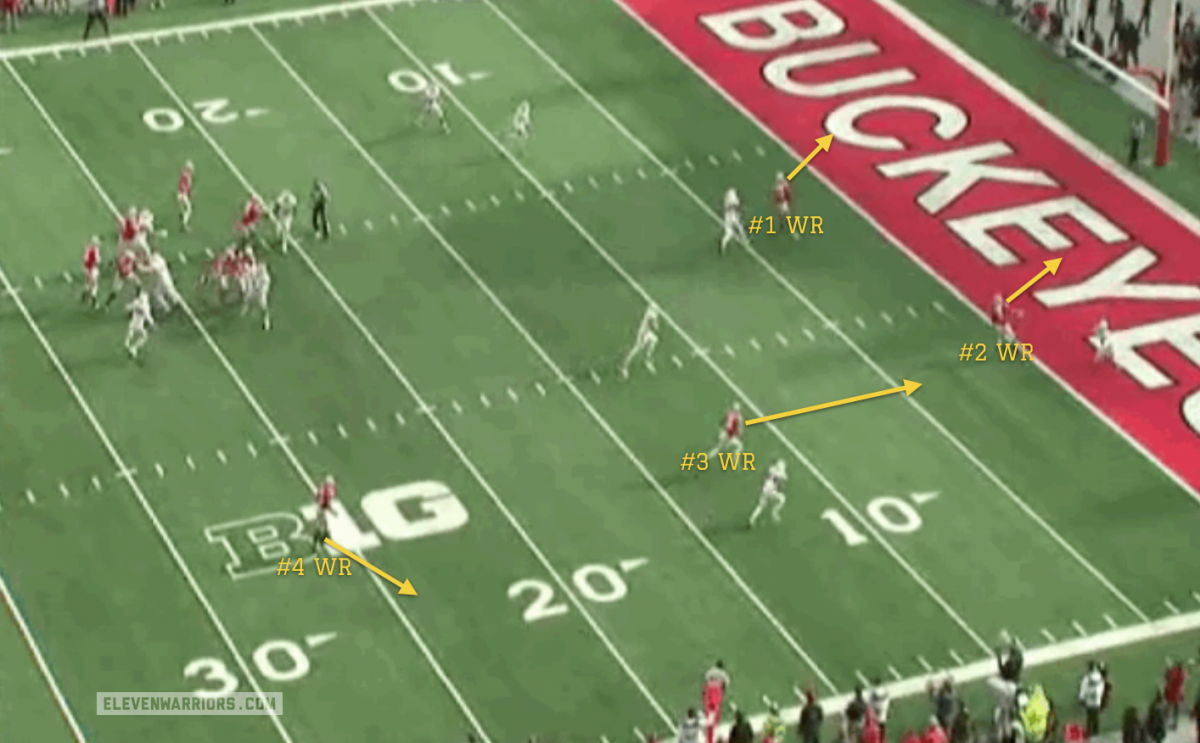
Both Jalin Marshall (the #1 receiver) and Thomas (#2) have at least two full steps on the trailing defenders with plenty of room in the end zone for Barrett to lead them with a throw. All the QB needed to do was put a pass on the 'C' or 'E' in BUCKEYES and he would have had another six points on the scoreboard. Instead, he hardly glanced at either before they've gotten enough depth to make a proper read, and simply locked on to Spencer, leading to the turnover.
With so much pressure on Barrett to carry his team in 2016, he can't just return to his old form, but he must improve upon it. For those of you heaping blame on co-coordinator and QB coach Tim Beck for last year's failures, now is your chance to find out if he's truly earning his paycheck. Beck was never making the decision between Barrett or Cardale Jones (that was Meyer), and he was never calling the plays (that was coordinator Ed Warinner, with plenty of input from Meyer).
But all three coaches are now culpable for the development of their star QB. Meyer must buy into the strategy of including more mid-range pass plays, Warinner must know when to call them, and Beck must make sure Barrett is prepared to execute them. If everyone plays their part, not only will J.T. Barrett reach new levels as a player, the entire Ohio State offense will as well.
